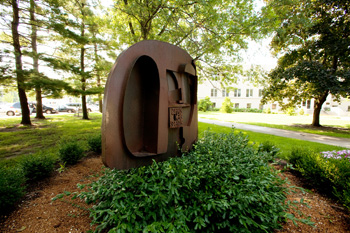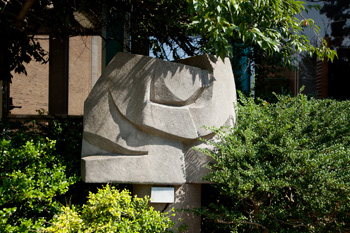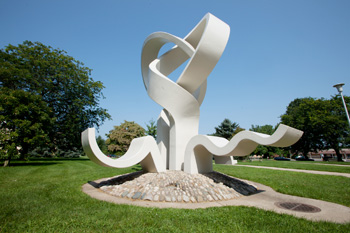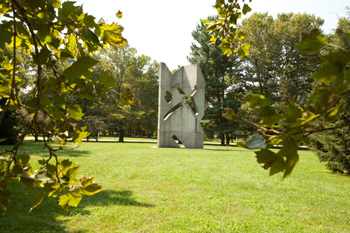Contact: pr@andrews.edu
Website:
Phone:
Have you ever wondered if there was a story behind the brown steel sculpture in front of the Administration Building? Perhaps you’ve walked by the sculpture in front of the Science Complex and questioned the purpose of the four elements extending from the core. There are four main sculptures positioned on the campus of Andrews University, each one with its own story.
Corten Steel Sculpture
Located between the Administration Building and Nethery Hall
The first piece of modern art came to Andrews University in 1966, as a gift from the graduating senior class. The 1,300-pound sculpture that rotates on its axis is made of Corten steel, a material designed to rust into a warm brown color over time, and was designed by Timothy Malone, who was a graduate student and part-time instructor at the University of Notre Dame at the time. The sculpture bears the University motto, "Corpus, Mens, Spiritus" on one side and an imperfect circle representing the globe and two curved meridian lines on the other. The sculpture was scheduled to be installed in December of 1966, but because of Malone’s illness and an imbalance in the piece, the installation was delayed until April of 1967. The piece sparked vicious controversy once it was installed, as it had not rusted to its full beauty. Many students thought it was an unsightly addition and deplored what they believed was a waste of money. In the era of student protests, some activists even threw paint on the piece shortly before graduation in 1967. Others were more accepting, and agreed that the sculpture would need time to integrate into the students’ mindset before it could be fully accepted.
 |
|
Corten Steel Sculpture |
“Wrestlers”
Located between the Johnson Gym and Bell Hall
Robert Slaughter was a senior art student in 1969 and wanted to attempt a large stone piece for his final project. The subject of wrestlers was chosen because itwould produce the most tension in the least space. It also represents the various struggles students wrestle with every day: financial, academic and spiritual. It took Slaughter four months, using old-fashioned hand sculpting tools to chip away at a two-ton chunk of limestone, to reveal the wrestlers. The piece was installed in early 1970.
 |
|
“Wrestlers” |
“Regeneration”
Located in front of the Science Complex
Designed specifically for the patio of the Science Complex in 1971, Alan Collins’ 22-foot sculpture “Regeneration” exudes life and energy. The sculpture was created as a complement to the rectilinear architecture of the Science Complex, and incorporates ideas central to the work of the Christian scientist. The looping, curving ribbon resembles the joining and division of molecules, the intricately twisted DNA molecule, or the form of a mandorla, a medieval symbol of Jesus Christ. At no point does the ribbon ever touch itself in its course, suggesting the course of life. The four forms extending out to passersby represent the four primitive elements—earth, air, water and fire—in subject (horizontal) forms at Jesus’ Second coming. The sculpture’s completion was scheduled to coincide with the dedication of the Science Complex, but unavoidable delays pushed its installation to fall of 1975. After the 22-foot high model was completed, two faculty members and a student worker spent most of the summer of 1975 computing the amount of steel rebar to reinforce the sculpture. Just less than two miles of steel rebar wind throughout “Regeneration,” covered by 60 tons of concrete.
 |
|
“Regeneration” |
Hazen’s concrete wall
Circle in front of Pioneer Memorial Church
The trees and stream of traffic around the PMC circle camouflage the powerful statement Wayne Hazen’s 26-foot high concrete behemoth makes. The piece itself is simple—forms of a cross and circle cut out of sharply angled concrete—but its symbols span all eternity. When President Richard Lesher learned that Hazen planned to leave the Andrews University faculty in 1985, he asked him to create a piece to leave with the University. He chose to make a 36-ton wall out ofconcrete and marble aggregate. The entire sculpture is meant to convey the power and love of God. The wall that rises solidly to the sky is bent at right angles, which signify stability and completion. The cross has been a symbol associated with Christianity since Jesus died, and still represents His sacrifice and love for us. The circle, long thought to be a pagan symbol, was the original symbol of God’s sustaining grace and perfection, and a daily reminder of our relationship with God.
 |
|
Hazen’s concrete wall |